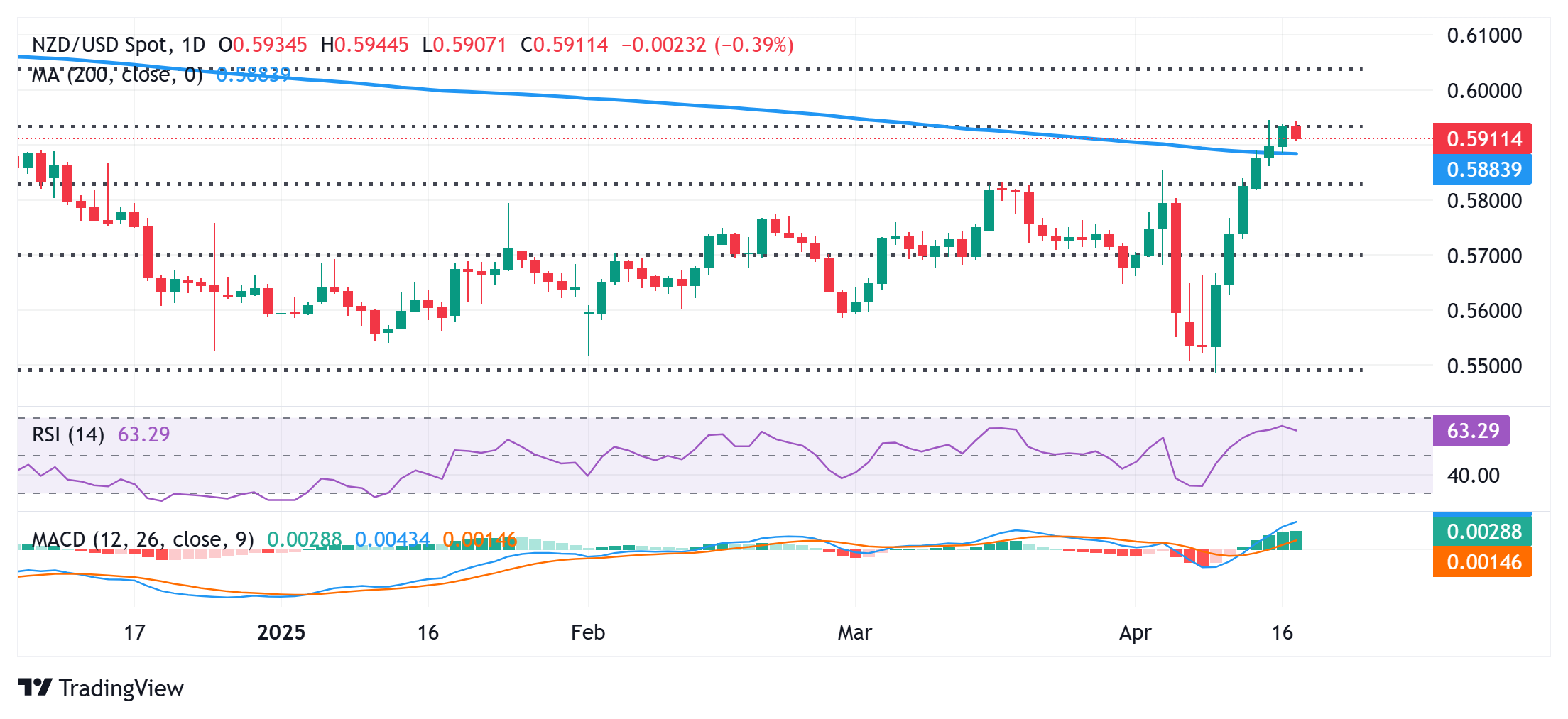NZD/USD Price Forecast: Extends rejection slide from 50% Fibo.; drops to 0.5900 neighborhood
- NZD/USD drifts lower despite stronger NZD CPI print and snaps a six-day winning streak.
- A modest USD uptick fails to assist spot prices to make it through the 50% Fibo. level.
- The bullish technical setup supports prospects for the emergence of some dip-buying.
The NZD/USD pair retreats from the vicinity of mid-0.5900s, or a fresh year-to-date high touched during the Asian session this Thursday, in reaction to stronger-than-expected consumer inflation figures from New Zealand. Spot prices drop to the 0.5900 neighborhood in the last hour and for now, seem to have snapped a six-day winning streak amid a modest US Dollar (USD) uptick.
Furthermore, the fact that the Consumer Price Index (CPI) remained comfortably within the Reserve Bank of New Zealand’s (RBNZ) 1–3% target range for a third consecutive quarter failed to shift expectations of further easing. This undermines the New Zealand Dollar (NZD) and contributes to the NZD/USD pair's slide from the 50% Fibonacci retracement level of the September 2024-April 2025 downfall.
Meanwhile, the recent breakout through the very important 200-day Simple Moving Average (SMA) for the first time since October 2024 was seen as a key trigger for bullish traders. Moreover, oscillators on the daily chart are holding comfortably in positive territory and are still away from being in the overbought zone. This, in turn, suggests that the path of least resistance for the NZD/USD pair is to the upside.
Hence, any subsequent fall might still be seen as a buying opportunity near the 0.5860-0.5855 region. This is closely followed by the 200-day SMA, currently around the 0.5840 zone, and the 0.5825 region, or the 38.2% Fibo. level, which should help limit any further decline. A convincing break below the latter, however, might prompt technical selling and drag the NZD/USD pair towards testing sub-0.5800 levels.
On the flip side, bulls might wait for sustained strength and acceptance above the 50% Fibo. level, around the 0.5930 region, before placing fresh bets. The NZD/USD pair might then accelerate the positive momentum towards the 0.5970 horizontal resistance en route to the 0.6000 psychological mark and the 61.8% Fibo. level, around the 0.6040 area.
NZD/USD daily chart

New Zealand Dollar FAQs
The New Zealand Dollar (NZD), also known as the Kiwi, is a well-known traded currency among investors. Its value is broadly determined by the health of the New Zealand economy and the country’s central bank policy. Still, there are some unique particularities that also can make NZD move. The performance of the Chinese economy tends to move the Kiwi because China is New Zealand’s biggest trading partner. Bad news for the Chinese economy likely means less New Zealand exports to the country, hitting the economy and thus its currency. Another factor moving NZD is dairy prices as the dairy industry is New Zealand’s main export. High dairy prices boost export income, contributing positively to the economy and thus to the NZD.
The Reserve Bank of New Zealand (RBNZ) aims to achieve and maintain an inflation rate between 1% and 3% over the medium term, with a focus to keep it near the 2% mid-point. To this end, the bank sets an appropriate level of interest rates. When inflation is too high, the RBNZ will increase interest rates to cool the economy, but the move will also make bond yields higher, increasing investors’ appeal to invest in the country and thus boosting NZD. On the contrary, lower interest rates tend to weaken NZD. The so-called rate differential, or how rates in New Zealand are or are expected to be compared to the ones set by the US Federal Reserve, can also play a key role in moving the NZD/USD pair.
Macroeconomic data releases in New Zealand are key to assess the state of the economy and can impact the New Zealand Dollar’s (NZD) valuation. A strong economy, based on high economic growth, low unemployment and high confidence is good for NZD. High economic growth attracts foreign investment and may encourage the Reserve Bank of New Zealand to increase interest rates, if this economic strength comes together with elevated inflation. Conversely, if economic data is weak, NZD is likely to depreciate.
The New Zealand Dollar (NZD) tends to strengthen during risk-on periods, or when investors perceive that broader market risks are low and are optimistic about growth. This tends to lead to a more favorable outlook for commodities and so-called ‘commodity currencies’ such as the Kiwi. Conversely, NZD tends to weaken at times of market turbulence or economic uncertainty as investors tend to sell higher-risk assets and flee to the more-stable safe havens.


